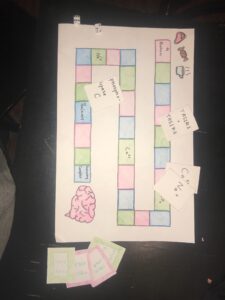For my STEAM project I decided to make a board game out of the taste sensory reception pathway. The metabotropic pathway as well as the board game starts at a G protein and ends at the Gustatory cortex in the frontal lobe. We learned about this pathway briefly, but I decided to take a deeper dive to understand more of the specific proteins and molecules used to pass the taste signal along. For me a board game that utilizes cards in place of specific molecules was a fun and effective way to learn the pathway all the way through. Here is a picture of the game board, some of the cards, and a link to the rules I made.

This should be viewable by everyone through their UA email

Jaden Frost
The action of tasting flavors in our mouth is an immense task to explain properly to someone. Parker chose the objective “how sensory cells translate stimulus into action potentials.” The taste buds in the tongue can detect 5 flavors: sweet, salty, sour, bitter and umami.
Bitter, umami and sweet flavors can be recognized by G proteins in the epithelial cells that are in taste buds. In order for an action potential to produce for these flavors, the tastant has to bind to a G protein. Although all 3 flavors bind to a G protein, they all have their own unique G protein that is associated with them. Multiple steps are then produced, but the end game is that sodium channels are opened to make the cell depolarized. Although the sodium channels open, it also opens another channel: Ca2+. Calcium then binds to Panx1 channels, and ATP is then released. The action potential then travels to the central nervous system, which is then processed through the thalamus region of the brain.
Parker’s sensory pathway explanation has a complete model that can be explained through the board game he created. The action to move forward in the board game has to be done by collecting cards that have actual meaning relating to the objective. PIP2 and Phospholipase C molecules have to be present in order for the release of calcium. Another channel that needs to be activated for an action potential is sodium. Calcium is also another channel that needs to be opened for an action potential, and these are both cards that need to be required in the game. The board game rules and requirements are identical to the requirements for a stimulus into action potentials.